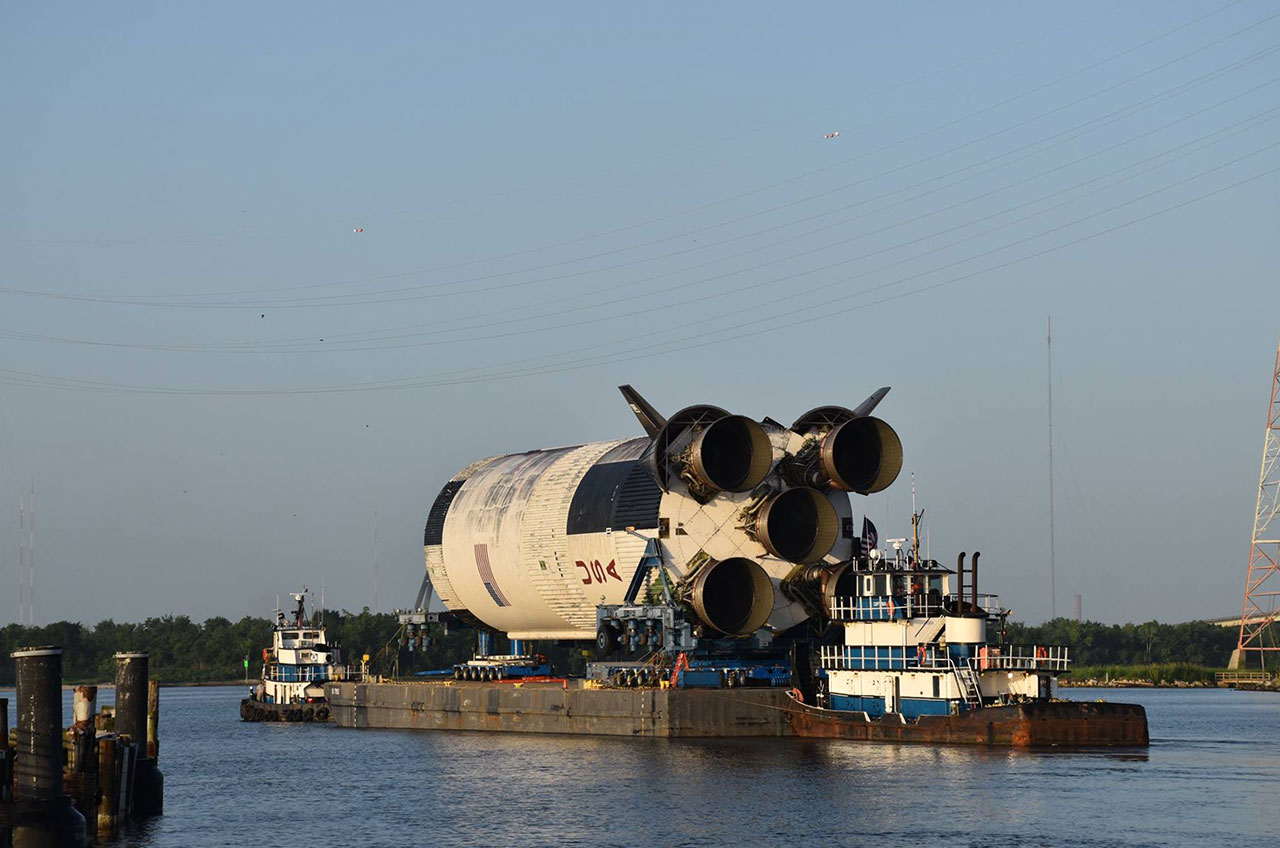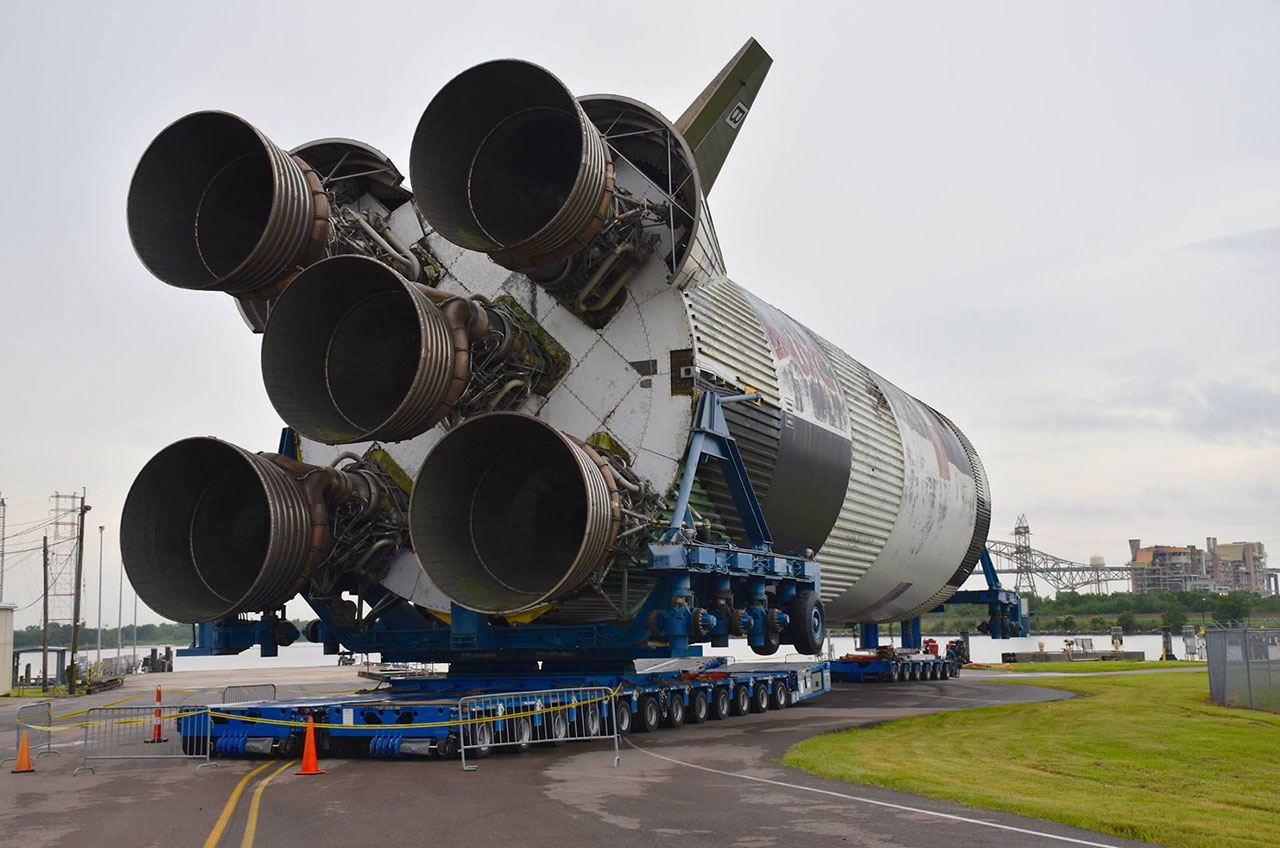NASA Saturn V Moon Rocket Stage Moving to Mississippi

More than four decades after its mission to the moon was canceled, NASA's last-assembled Saturn V rocket stage has been launched on a journey to become a roadside attraction.
"We are putting it on display along Interstate 10, one of the most heavily traveled interstates in the country. People will be able to see it as they enter Mississippi from Louisiana," said John Wilson, executive director of the Infinity Science Center in Pearlington, Mississippi.
Built to be the "business end" for the tallest, heaviest and most powerful booster ever launched, the massive Saturn V S-IC first stage was the last of its type made when it was completed in 1970. It was intended to lift off on the Apollo 19 lunar landing mission in 1973; instead, it was parked at the entrance to its assembly facility in 1978, where it has remained ever since — until today (June 16). [NASA's Might Saturn V Moon Rocket Explained (Infographic)]
Now loaded onto a barge, the S-IC stage with its five rear-mounted F-1 rocket engines is headed from its "birthplace" and home of 38 years, NASA's Michoud Assembly Facility in New Orleans, to Stennis Space Center in Mississippi, where it had once been test fired in September 1970. The trip is expected to take two days.
"By water, it'll be approximately 40 miles [64 kilometers]," said Wilson. "It [is leaving] the Michoud Assembly Facility via the Intercoastal Waterway and then it'll enter the Pearl River, head north and will be off-loaded at Stennis Space Center."
Then, on Monday evening (June 20), the 138-foot-long (42 meter) stage will be transported to its new display site.
"The transit on Highway 607 is about 2.5 to 3 miles [4 to 4.8 km]. Then we will take a right and head westbound on the interstate," Wilson described.
Get the Space.com Newsletter
Breaking space news, the latest updates on rocket launches, skywatching events and more!
The stage will travel along the westbound side of I-10 until it reaches the bridge crossing Pearl River. It will then cross over to the eastbound side of the road to complete the trip to the science center.
"Over land, total, it will be about 6 to 7 miles [10 to 11 km]," stated Wilson, adding that the stage is expected to arrive early Tuesday (June 21).
Dignitaries, including Mississippi Governor Phil Bryant and astronaut Fred Haise, who was slated to command Apollo 19 after surviving the problem-ridden Apollo 13 mission in April 1970, will then help welcome the S-IC rocket stage to the Infinity Science Center at an invite-only ceremony later that morning.
"It is a tremendous icon that will be visible to the 8.5 million cars that go by," said Haise, who serves as vice chairman on the Infinity Science Center's board of directors. "It is a great icon for several reasons. We're kind of the entrance to Mississippi from Louisiana, so it is a landmark that not only distinguishes the science center, but also the kind of work that has been going on at Stennis and at the Michoud manufacturing facility, a hidden part of the [space] program to a lot of people." [NASA's Saturn V vs. Space Launch System (Video)]

"To local people and Mississippi state legislators, it is also a good thing to boost tourism," Haise told collectSPACE. "Personally, I wish it was in the Atlantic Ocean, because [it means] I would have flown aboard it, but nonetheless it is a keepsake that is good to have."
NASA launched 13 Saturn V boosters between 1967 and 1973, including nine that flew crews to the moon and one that deployed the United States' first space station, Skylab. Nineteen S-IC stages were built, including four ground test units, of which only four remain today.
The stage on its way to the Infinity was assigned the serial no. 515.
"Our purpose is to conserve and protect it," Wilson said. "It has been sitting outside since it was built, more or less. We have got a lot of work to do to raise the money to help conserve it. The state of Mississippi has been gracious in giving us the money to move it."
The science center intends to eventually erect a building to display the S-IC stage in such a way that it highlights how the rocket parts were moved between their assembly, test and launch facilities.
"It was one thing to dream up this big hardware and to train up the astronauts who would go on the mission, but in the background somebody had to figure out, 'Oh my god, how are we going to move all of this stuff around?'" stated Wilson. "It took 'ginormous' vehicles to do that, and barges and tugs and rivers and intercoastal waterways."
Ultimately, the hope is to increase awareness of the area's role in the historic moon landing missions.
"We are putting it in a highly visible location and hopefully it will serve to rekindle people's interest in the mighty days of the Apollo program and the rockets that took us there," said Wilson.
See more photos of the Saturn V SI-C stage's journey to the Infinity Science Center at collectSPACE.com.
Follow collectSPACE.com on Facebook and on Twitter at @collectSPACE. Copyright 2016 collectSPACE.com. All rights reserved.
Join our Space Forums to keep talking space on the latest missions, night sky and more! And if you have a news tip, correction or comment, let us know at: community@space.com.

Robert Pearlman is a space historian, journalist and the founder and editor of collectSPACE.com, a daily news publication and community devoted to space history with a particular focus on how and where space exploration intersects with pop culture. Pearlman is also a contributing writer for Space.com and co-author of "Space Stations: The Art, Science, and Reality of Working in Space” published by Smithsonian Books in 2018.In 2009, he was inducted into the U.S. Space Camp Hall of Fame in Huntsville, Alabama. In 2021, he was honored by the American Astronautical Society with the Ordway Award for Sustained Excellence in Spaceflight History. In 2023, the National Space Club Florida Committee recognized Pearlman with the Kolcum News and Communications Award for excellence in telling the space story along the Space Coast and throughout the world.

